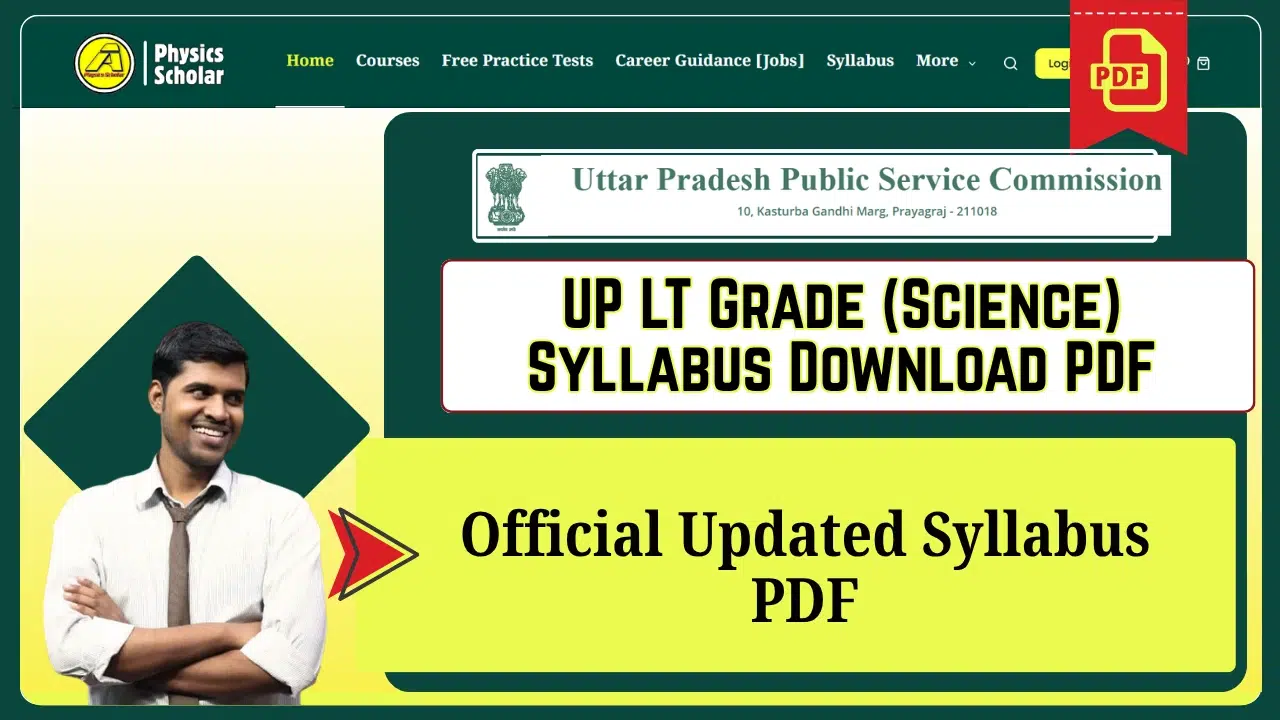[UPPSC] UP LT Grade Science Syllabus PDF Download | New Pattern: [Pre + Mains] Syllabus in Hindi & English

Are you preparing for the UP LT Grade Science Teacher exam and looking for the official syllabus to kickstart your journey? The UP LT Grade Science Teacher Syllabus PDF is a crucial resource, offering a detailed roadmap of topics in Physics and Chemistry, along with General Studies, to help you excel in the 2025 recruitment drive.
At Physics Scholar, we’ve created this comprehensive, user-friendly guide to walk you through the process of downloading the syllabus PDF, understanding its importance, and using it effectively. Plus, we’ve interlinked it with our detailed guide on how to become a UP LT Grade Science Teacher to ensure you have all the tools for success!

Why the UP LT Grade Science Teacher Syllabus PDF is Essential
The UP LT Grade Science Syllabus PDF is your key to mastering the exam conducted by the Uttar Pradesh Public Service Commission (UPPSC). With approximately 7,385 vacancies expected in 2025, this document outlines:
- Core Subjects: Physics, Chemistry, and Biology at the graduate level.
- General Studies: Current affairs, Indian history, geography, and Uttar Pradesh-specific knowledge.
- Exam Focus: Helps you prioritize high-weightage topics like Mechanics, Organic Reactions, and Human Physiology.
Downloading and studying this syllabus ensures you align your preparation with UPPSC’s expectations, maximizing your chances of clearing the written exam and interview.
UP LT Grade Science Teacher Syllabus [New Pattern Pre + Mains Syllabus PDF]
The UP LT Grade Science Teacher syllabus is comprehensive, blending General Studies with a deep dive into Science (Physics and Chemistry). Here’s a detailed breakdown:
![UP LT Grade Science Teacher New Exam Pattern [Pre + Mains]](https://physicsscholar.com/wp-content/uploads/2025/07/image-28.png)
Part 1: General Studies Syllabus
![UP LT Grade Science Syllabus [General Study]](https://physicsscholar.com/wp-content/uploads/2025/07/image-6.png)
- History of India and Indian National Movement:
- Broad understanding of social, economic, and political aspects of Indian history.
- Synoptic view of the freedom movement, growth of nationalism, and independence.
- Indian and World Geography:
- Physical, social, and economic geography of India.
- General understanding of world geography.
- Indian Polity and Governance:
- Constitution, political system, Panchayati Raj, public policy, and rights issues.
- Indian Economy and Social Development:
- Issues related to population, environment, urbanization, and economic policy.
- Broad features of Indian culture.
- Current Events of National and International Importance:
- Includes games and sports.
- Indian Agriculture:
- General understanding of agriculture, produce, and marketing in India.
- General Science:
- Appreciation of science, everyday observations, and India’s scientific development.
- Elementary Mathematics (up to Class 10):
- Arithmetic, algebra, and geometry.
- Focus on Uttar Pradesh: General awareness with special reference to UP.
Part 2: Science Syllabus
(A) Physics
![UP LT Grade Science Syllabus [Physics]](https://physicsscholar.com/wp-content/uploads/2025/07/image-7.png)
1. General Physics (Mechanics)
- Units and dimensions, vector and scalar quantities, product (scalar and vector products)
- Gradient, divergence and curl, Gauss’s and Stokes’ theorems and uses
- Momentum, force and acceleration, equations of motion
- Kinetic and potential energy, linear and angular momentum
- Conservation of energy and momentum, conservative and non-conservative forces
- Rotational motion, centrifugal and centripetal forces, gravitational force, central force
- Kepler’s laws of planetary motion, geostationary satellites, acceleration due to gravity, escape velocity
- Simple and compound pendulums, moment of inertia
- Parallel and perpendicular axis theorems, moment of inertia of sphere, ring, disc and cylinder
- Angular momentum and moment of force
- Streamline and turbulent flow, kinetic velocity, Stokes’ and Poiseuille’s formulae
- Bernoulli’s theorem and uses
- Surface tension, excess pressure inside curves of liquids, surface energy, flow of fluid in a capillary
- Elasticity: Coefficient of elasticity, mutual relations among them, bending moment, cantilever
- Theory of relativity, change in length, time and mass, mass-energy equivalence
2. Heat
- Concept of heat and temperature, different temperature measurement scales, absolute temperature
- Thermal expansion of solids, gases and liquids, good conductors and bad conductors
- Radiation of heat, black body radiation, Rayleigh’s and Wien’s laws, Planck’s radiation formula
- Newton’s law of cooling, Stefan’s law, internal energy
- Isothermal and adiabatic changes, first and second laws of thermodynamics
- Carnot engine, entropy, Maxwell’s thermodynamic relations
- Joule-Thomson effect, Clausius-Clapeyron equation
3. Waves and Oscillations
- Simple harmonic motion, progressive and stationary waves
- Phase and group velocity, damped harmonic motion, forced oscillations and resonance
- Resonance intensity, superposition of waves, pulsating and Lissajous figures
- Doppler effect
4. Optics
- Spherical mirrors and lenses, refractive index, focal length formulas, equilateral systems
- Combination of thin lenses, eyepiece, Ramsden and Huygens eyepieces
- Chromatic defects of lenses, human eye, farsightedness, nearsightedness
- Interference, basic concepts of diffraction and polarization
- Biprism, Newton rings, Fresnel-Fraunhofer diffraction, Rayleigh criterion
- Resolving power, working principle of zone plate and gratings
- Double refraction, plane, circular and elliptical polarization
- Quarter and half wave plate, general concept of laser, ruby and helium-neon laser
5. Electricity and Magnetism
- Primary and secondary cells, internal resistance, electromotive force
- Resistance and capacitors, laws of combination, current, drift velocity and conductivity
- Galvanometer, ammeter and voltmeter, Wheatstone bridge and experiments
- Bio-Savart law, Ampere’s circuital law, electromagnetic induction
- Faraday and Lenz’s laws, self-induction and mutual induction
- Alternating current, series and parallel (LCR) circuits
- Basic information about anti-ferromagnetism, electromagnetic Maxwell’s equations
- Displacement current, electromagnetic waves
6. Modern Physics
- Structure of atom, vector and Bohr models of atom, Pauli’s exclusion principle
- Optical and X-ray spectra, photoelectric effect, Compton effect
- Zeeman, Paschen-Back and Raman effects, DeBroglie waves, uncertainty principle
- Schrödinger equation, radioactivity
- Metals, semiconductors and insulators, P-N junction, Zener diode, transistor and their uses
- Logical gates, truth tables, Boolean algebra
(B) Chemistry
![UP LT Grade Science Syllabus [Chemistry]](https://physicsscholar.com/wp-content/uploads/2025/07/image-5.png)
- General Organic Chemistry:
- Hyperconjugation, inductive effect, resonance, aromaticity, electrophiles, nucleophiles, reaction intermediates (carbocation, carbanion, free radical, carbene, benzyne).
- Reaction Mechanisms:
- SN1, SN2, E1, E2 reactions, electrophilic/nucleophilic additions, aromatic substitution, ortho/para/meta directing groups.
- Named reactions: Aldol, Perkin, Cannizzaro, Benzoin, Wittig, Reimer-Tiemann, Hoffmann Bromamide, Knoevenagel, Michael addition.
- Carbohydrates:
- Glucose and fructose: Mutarotation, osazone formation, oxidation, reduction.
- Polymers:
- Natural (starch, cellulose, rubber, silk) and synthetic (nylon, terylene, polyethylene, PVC, Teflon).
- Isomerism:
- Structural and stereoisomerism (enantiomerism, diastereomerism, R/S, E/Z nomenclature).
- Absorption Spectroscopy:
- UV: Chromophores, auxochromes, bathochromic/hypsochromic shifts, Woodward-Fieser rule.
- IR: Functional group frequencies and influencing factors.
- Structure of Atom:
- Bohr’s model, quantum numbers, modern atomic theory.
- Periodic Properties:
- Atomic/ionic radii, ionization potential, electron affinity, electronegativity, lattice/hydration energy, solubility.
- Chemical Bonding:
- Ionic, covalent, coordinate, hydrogen bonding, molecular shapes.
- Coordination Chemistry:
- 3d block elements, nomenclature, ligands (monodentate, bidentate, polydentate), Werner/VB theory, biological compounds (hemoglobin, myoglobin, vitamin B12, chlorophyll).
- Oxidation and Reduction:
- Oxidation number, redox reactions, standard electrode potential.
- Radioactivity:
- Natural decay, α, β, γ rays, half-life, nuclear fission/fusion.
- Chemical Kinetics and Catalysis:
- Molecularity, order (zero, first, second), catalytic/enzymatic reactions.
- Thermodynamics:
- First/second laws, enthalpy, heat capacity (C_v, C_p), extensive/intensive properties.
- Chemical Equilibrium:
- Law of mass action, Le-Chatelier principle, K_p/K_c, activity coefficients.
- Ionic Equilibrium:
- Dissociation constants (K_a, K_b), salt hydrolysis, solubility product, buffer solutions, pH.
Expert Tip: The syllabus aligns with NCERT textbooks (Classes 6-10) and B.Sc. level books.Download the official UP LT Grade Teacher syllabus PDF from www.uppsc.up.nic.in for precision.
Steps to Download the UP LT Grade Science Syllabus PDF
Follow these simple steps to access the official syllabus PDF:
- Visit the Official UPPSC Website:
- Open your browser and go to www.uppsc.up.nic.in, the official portal of the Uttar Pradesh Public Service Commission.
- Navigate to the Syllabus Section:
- On the homepage, look for the “Syllabus” or “Examination Syllabus” link under the “Candidate’s Corner” or “What’s New” section.
- Select LT Grade Teacher Exam:
- Find the link for the UP LT Grade Teacher 2025 Syllabus or search using keywords like “LT Grade Science Teacher Syllabus.”
- Click on the relevant link for the Assistant Teacher (Science) post.
- Download the PDF:
- The syllabus will be available as a downloadable PDF. Click the download button or right-click to save the file to your device.
- Ensure you have a PDF reader (e.g., Adobe Acrobat) installed to view it.
- Verify the Document:
- Check that the PDF includes sections for General Studies (30 questions) and Science (120 questions), covering Physics and Chemistry, as per the latest pattern.
Alternative Source: If the official link is unavailable, visit Physics Scholar for a verified copy or updates, though always cross-check with UPPSC for authenticity.
Importance of the Syllabus PDF for Exam Preparation
The UP LT Grade Science Teacher Syllabus PDF is more than just a list of topics—it’s your strategic guide:
- Topic Prioritization: Focus on high-scoring areas like Mechanics, Chemical Bonding,…
- Time Management: Plan your study schedule based on the weightage of each section.
- Mock Test Alignment: Use the syllabus to create or source practice tests matching the exam format.
- Confidence Boost: Knowing the exact scope reduces guesswork and builds exam readiness.
Pair this with regular practice using Previous Year Questions (PYQs) available on Physics Scholar to stay ahead.
How to Use the Syllabus PDF Effectively
- Break It Down:
- Divide the syllabus into daily/weekly goals. For example, dedicate a week to Physics (Mechanics, Electromagnetism) and another to Chemistry (Organic Reactions).
- Cross-Reference with Resources:
- Use NCERT textbooks (Classes 6-10) for basics and advanced books like H.C. Verma (Physics) or Morrison & Boyd (Chemistry) for depth.
- Track Progress:
- Highlight completed topics and revisit challenging areas like Thermodynamics or Ionic Equilibrium regularly.
- Integrate with Preparation:
- Link your study plan to the detailed guide on How to Become a UP LT Grade Science Teacher, which offers a step-by-step roadmap, mock test strategies, and interview tips.
Troubleshooting Download Issues
- Website Unavailable: Try again later or use the UPPSC helpline (available on the website) for support.
- Broken Link: Search for “UP LT Grade Syllabus 2025 PDF” on the UPPSC site or contact us at Physics Scholar for assistance.
- File Corruption: Re-download the PDF and ensure a stable internet connection.
Stay Updated with Physics Scholar
At Physics Scholar, we’re committed to your success in the UP LT Grade Science Teacher exam. Alongside the syllabus PDF, explore:
- Free PYQs PDFs: Download solved questions to practice the exact format.
- Expert Tips: Strategies to tackle the 150-question, 2-hour exam with no guesswork.
- Latest News: Updates on the 7,385 vacancies and exam dates (expected soon in 2025).
Visit Physics Scholar to access these resources and connect with a community of aspirants.
Final Thoughts
Downloading the UP LT Grade Science Teacher Syllabus PDF is your first step toward a rewarding teaching career in Uttar Pradesh. Combine it with the comprehensive preparation guide on How to Become a UP LT Grade Science Teacher to master eligibility, exam patterns, and interview skills. Start today, stay consistent, and leverage free resources from Physics Scholar to turn your dream into reality!
Best of luck for your UP LT Grade Science Teacher 2025 journey—download, prepare, and succeed!

[…] syllabus aligns with NCERT textbooks (Classes 6-10) and B.Sc. level books. Download the official UP LT Grade Teacher syllabus PDF from http://www.uppsc.up.nic.in for […]
Sir isko bhi btayiye ki kon se topic se kitna question aayega
It’s very helpful
Anupsir jaisa koi nhi
Thanks sir
[…] PYQs with the UP LT Grade Science Teacher Syllabus PDF to ensure comprehensive […]